
Today we want to look at the negative impact that inventory can have upon our profits and performance. Consider a few examples of our inventory “gone wild.”
- There is no actual inventory management control…we either have too much of what we don’t need or not enough of what we need daily
- When workers go to the “normal place” to find a needed component, it’s completely empty…and no one was alerted to re-order
- Because we always seem to need that part, we double or triple the quantity of part purchased and kept in stock
- When ordering material from the plant late in the afternoon we order 10% to 15% more “just in case”
- One crew cleans out the few remaining rebar clips or finishing trowels leaving the other crews to their own devices
- We order extra tablets and pens because they seem to “walk off at night and the boss is always needing a pad to take notes”
- We order a bunch of extra supplies including oil and hydraulic fluid at the end of the year because we think we’re going to do our major equipment maintenance
- 500 company logo’d shirts are purchased because it was cheaper per shirt cost than ordering 100 shirts
- Because things disappear, the contractor is the “key holder” to the locked stock room and he’s not around to allow crew foreman access to getting needed items for job…so the foreman buys the same items at contract supply store at double the cost
Inventory management is admittedly one of the last areas for standardization. Poorly managed, a contractor can experience higher than needed costs associated with buying extra of everything so that “we never run out.” Likewise, a poorly organized and maintained inventory management system can leave your people without important tools, components, etc. needed to effectively complete their jobs.
Whether your inventory management effort is creating too much inventory or not enough, the lack of inventory management is costing you in many ways, including:
- Crews are buying more and more tools and components at supplier stores (such as Home Depot and Lowes) where we do not have volume discounts…thus raising your costs needlessly
- Crews are waiting longer for parts, tools and other items to be found due to poor management of the inventory that we do have
- Workers are using something other than the right tool, part or component because the “right” item is out of stock
- Your better workers are developing an attitude because they can never find what they need when they need it
- Poor inventory management is just a symptom of other ineffective efforts that are slowly, but surely, eating away at your profits as you “nickel and dime” your buying habits
Now, for many contractors, their “store” or “crib room” is their truck. Some might even have a “tool truck” that serves as their tool crib on wheels. If this is your situation, you can still practice the technique I’m about to share.
If you are a larger contractor who has a yard, a tool crib, etc., and you have some form of inventory management, then certainly you have the challenge of making sure that not everyone has access to just pulling from stock whatever they want, whenever they want to, without completing the proper paperwork or letting the appropriate person know!
In short, inventory management is for every contractor.
So, let’s put in place some guidelines for effective inventory management. Consider the following recommendations for effective inventory management (EIM)…also known as taking control of “stuff.”
Create accurate list of “perishable & non-perishable” resources
Ok, this may be the hardest action you take. You have to start somewhere, and the first thing you need to do is perform an accounting of everything you have in your company that assists you and your people to be a quality contractor.
To assist you with this effort, I’ve broken all that you possess into two categories: perishable and nonperishable resources. First, perishable resources are items that are designed to be used up one way or another. Examples here might include:
- Saw blades
- Oil filters
- Screws and bolts
- Engine belts
- Note pads
- Pens and markers
You get the idea? Now be careful, this is the exact “stuff” that often disappears. I mean, be realistic: what contractor has not personally taken a few extra note pads home with him because his college student son or daughter called and said, “I need some note pads for class”?
Non-perishable resources are considered long-lasting, such as:
- Equipment
- Tools: power and non-power
- Computers, iPads, printers, etc.
- Shop-vac, blowers, etc.
- Ladders
- Company vehicles
Again, I think you can draw the difference. The point here is to recognize the difference between items that will be used up and those items that need maintaining.
Create “min & max” quantities for perishable resources
In order to have what your crews need and to manage the inventory and budget, you need to establish the minimum and maximum amounts of perishable resources you feel comfortable keeping in stock.
Create color-coded tabs or index cards that have the minimums and maximum amounts recorded, the name of the item and the re-order amount. This will alert those individuals who are pulling stocked items to act on whatever the parts card requests.
Establish a procurement manager to maintain proper inventory levels
Depending on the size of the construction company, the procurement manager might be the contractor, the contractor’s spouse, a foreman or a hired manager who has primary responsibility of balancing budget costs, negotiating pricing and quantities with vendors, and reordering of perishable resources when needed.
Along with this third recommendation you should set up a process, a standard operating procedure, that spells out what actions are to be taken to maintain an inventory level and system that is to be respected by everyone.
Maintaining an inventory management process is hard work, and you will find a great number of instances where that process is not followed. While rules are occasionally bent, be careful about bending inventory rules too often as the dollars will start disappearing faster than you can shake a stick.



















